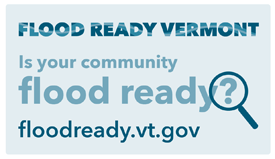Flood Resilience Planning
Information for Municipal Plans
Any municipal or regional plan adopted or readopted after July 1, 2014 must include a flood resilience plan element. Those plans adopted before that date will continue to remain in effect until expiration or until they are amended or readopted, at which point they must include the new flood resilience plan element. The bill also requires ANR to establish a program to aid and support municipalities in adopting the new plan element. View Summary of Act 16: Municipal & Regional Flood Resilience Plan Legislation >>
Current Resources:
- Fluvial Erosion Hazard Maps and Language. While inundation-related flood loss is a significant component of flood disasters, the predominant mode of damage is fluvial (river-related) erosion. Fluvial erosion hazard mitigation can lead to enhanced public safety and reduce long-term flood damages. Contact Brian Voigt (voigt@cvregion.com) if your town is interested in assistance with Fluvial Erosion Hazard area mapping and regulations. View ANR’s Municipal Guide to Fluvial Erosion Hazard Mitigation >>
- Municipal Hazard Mitigation Plans. Nineteen towns have had their Local Hazard Mitigation Plans (LHMP) approved by FEMA and four towns LHMPs available in final draft form. Contact us at cvrpc@cvregion.com for these files or the approved LHMPs for each town are available for download from CVRPC’s website. View the Local Hazard Mitigation Plans >>
- Draft Past Flood Events Table. Staff compiled a table of past flood events that impacted the Central Vermont Region as part of the 2016 Regional Plan Update process. Contact us at cvrpc@cvregion.com for more information. View the Draft Past Flood Events Table >>
- Flood Ready Vermont.
 This online tool can help communities prepare for disasters, identify flood hazards, take action to minimize future damage, find funding to reduce risk to existing buildings, and update municipal plans. Visit Flood Ready Vermont >>
This online tool can help communities prepare for disasters, identify flood hazards, take action to minimize future damage, find funding to reduce risk to existing buildings, and update municipal plans. Visit Flood Ready Vermont >> - Disaster Recovery and Long-Term Resilience Planning in Vermont. A framework for local flood resilience created with help from the EPA-Smart Growth Implementation Assistance (SGIA) program, organizations in the Mad River Valley and state agency and regional partners. View the Mad River Valley report >>
View DHCD’s Rebuilding Stronger >> - Preparing for the Next Flood: Vermont Floodplain Management. This 2009 publication of the Vermont Law School provides a short but thorough overview of the issues and terminology associated with municipal management of floodplains. View the Vermont Law School publication >>
- Floodplain Fact Sheets. The Two Rivers-Ottauquechee Regional Commission (TRORC) presents a series of six fact sheets to help educate local officials and residents about flood hazards and floodplain management. View TRORC publications >>
- Flood Damage Mitigation Incentives for Municipalities under the New ERAF Rule. A summary by VLCT of the ERAF (Emergency Relief and Assistance Fund) rule defining the state-recommended mitigation measures for towns to become eligible for state funding on the match required for FEMA Public Assistance grants. More on this below. View VLCT Summary of the ERAF rule >>
- Agency of Natural Resources (ANR) River Management Division Publications/Resources. Access to key legislation and publications dealing with flood resilience and related topics. Visit ANR’s Rivers Program >>
- Vermont’s Roadmap to Resilience. The Institute for Sustainable Communities recently released a long term strategy for a resilient Vermont that integrates related state, regional, and local initiatives in order to better prepare the state to address the effects of climate change and impacts of extreme weather events. Visit ISC’s Roadmap to Resilience >>
Emergency Relief and Assistance Fund Rule: Download ERAF factsheet here.
The Emergency Relief and Assistance Fund (ERAF) Rule provides the potential for municipalities to reduce their share of costs associated with Federally declared disasters. ERAF provides State funding to match Federal Public Assistance after federally-declared disasters. Eligible public costs are reimbursed by federal taxpayers at 75%. Municipalities are responsible for the remaining 25% of costs. The ERAF Rule authorizes the State of Vermont to reimburse municipalities for a portion of their cost share based on specific actions a municipality has taken. The State may reimburse a municipality between 7.5% and 17.5% based on the municipality’s actions.
The State will contribute a base amount of 7.5% of the total Public Assistance for all eligible municipalities.
The State may increase its contribution to 12.5% of the total Public Assistance when a municipality has:
- Adopted town and road bridge standards consistent with or exceeding those listed under the most current version of Town Road & Bridge Standards, Handbook for Local Officials, published by VTrans;
- Adopted a flood hazard bylaw, or interim flood hazard bylaw as an intermediary step (24 VSA §4414), to secure enrollment and participation in the National Flood Insurance Program (NFIP), if applicable;
- Approved a local Hazard Mitigation Plan that meets the provisions of 44CFR § 201.6. The Plan must be in the process of securing final approval by FEMA. The local mitigation plan may be part of a larger regional mitigation plan; and
- Adopted a local Emergency Management Plan (LEMP) in accordance with State standards.
The State may increase its contribution to 17.5% of the total Public Assistance when a municipality either:
- Maintains an active rate classification (class #1- 9) under FEMA’s Community Rating System (CRS) that includes activities that prohibit new structures in mapped flood hazard zones or
- Adopts a Fluvial Erosion Hazard (FEH) or other river corridor or floodplain protection bylaw that meets or exceeds the ANR FEH model regulations and scoping guidelines.
Green Infrastructure Municipal Outreach Project
CVRPC is also engaged in a Green Infrastructure project to help the state implement the Green Infrastructure Strategic Plan, and to specifically conduct outreach and technical support for promotion and adoption of green infrastructure practices at the municipal level. Visit Green Infrastructure Planning for more information on CVRPC’s Green Infrastructure Municipal Outreach Project.
